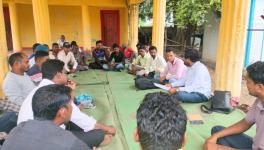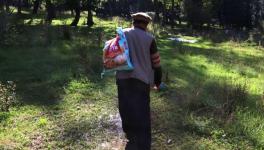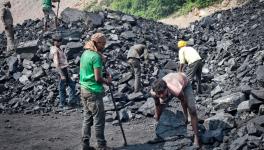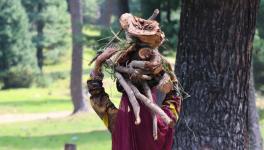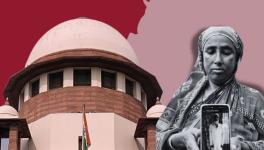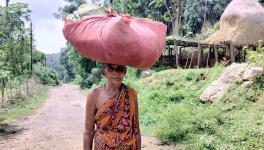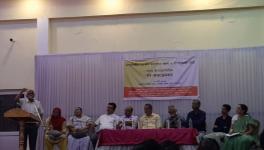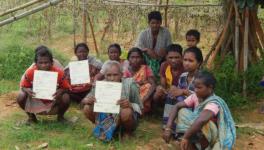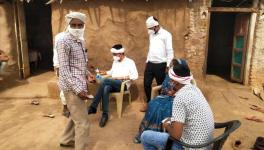Gotte Koyas: The ‘Nowhere’ People and Their Struggle for Identity
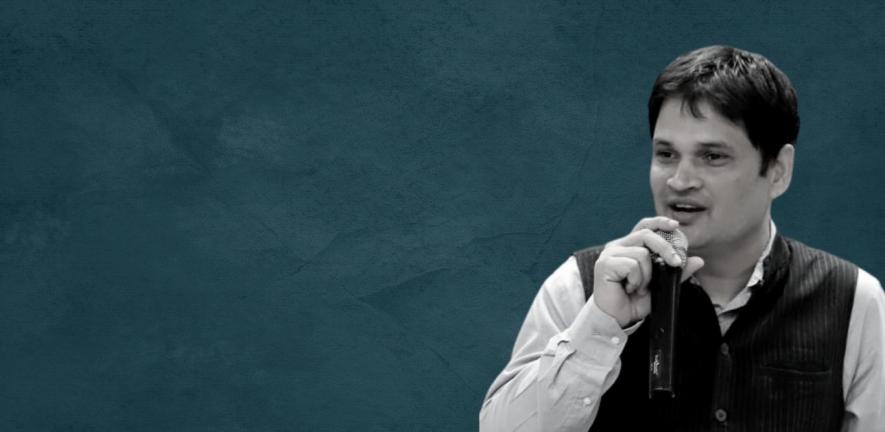
Although the Gotte Koyas are living in deplorable conditions for the past 15 years, the mainstream media fails to raise their concerns, says researcher Dr. Anshuman Behera.
– –
In 2005, Salwa Judum, a militia supported by the Chhattisgarh government, was mobilised to counter the violence caused by the Maoists in the state. The Gotte Koyas, a marginalised tribal community from Chhattisgarh, was caught in the crossfire between Salwa Judum and the Maoists. With the escalation of violence, the Gotte Koyas were forced to flee their native lands in Chhattisgarh and migrated to different states, with the majority presently living in the state of Telangana. As a displaced marginalised group, the Gotte Koyas continue to face human rights abuses. As per one estimate, around 55,000 displaced Gotte Koyas are now living in Andhra Pradesh, Telangana and Odisha, with the majority found in the Mulugu and the Bhadradri Kothagudem districts of Telangana.
Dr. Anshuman Behera, an Associate Professor in the Conflict Resolution and Peace Research Programme at the National Institute of Advanced Studies, Bengaluru, has conducted extensive research on the Maoist conflict in India and has expertise in the field of political violence in South Asia.
In this interview, Dr. Behera answers specific questions from The Leaflet on the continued plight of Gotte Koyas on account of the omissions and commissions of the Chhattisgarh and Telangana governments, the status of Internally Displaced Persons in India, and the steps needed to ensure the protection of their basic rights.
Q: Can you explain why the Gotte Koyas are termed as ‘nowhere people’ in your writings?
A: As a writer’s prerogative, I have used ‘nowhere people’ as an emotionally loaded term to indicate an involuntary migration and the state of statelessness of a marginalised group. The Gotte Koyas migrated to the forests of Telangana, or the undivided Andhra Pradesh during 2005-2006, and some parts of Odisha. It was not a voluntary movement, and they would have never left Chhattisgarh.
It is important to understand the extraordinary situation where the State had subleased its power to a group called Salwa Judum, the extra-legal body that used violence to fight the violence by the Maoists. In our social contract, we all have consciously delegated our power to the State. Unfortunately, when an ill-willing group took up arms to fight the State’s sovereignty or the State’s power, the State subleased its power to Salwa Judum, which was declared to be illegal and unconstitutional by the Supreme Court in July 2011.
In 2005, the Maoist violence was experienced at its peak in Chhattisgarh, where the Gotte Koyas and other marginalised groups were the unfortunate victims of the fight between the Maoists and the State. Contrary to popular understanding, these groups did not take any side, that is, they neither subscribed to Maoism nor Salwa Judum. Such an extraordinary situation led to the involuntary movement of the Gotte Koyas from one state to another.
The Gotte Koyas are ‘nowhere’ because there is absolutely no protection given to them. The responsibility is directly of the administration, whether it is the state government of Chhattisgarh or the Union Government. Thus, it is the failure of the State to protect its citizens against anybody who takes up arms illegally or unconstitutionally.
Q: You have referred to the Gotte Koyas as Internally Displaced Persons (IDPs). Who are IDPs and what is their status in India?
A: According to some conservative calculations, there are close to five lakh people who are internally displaced in India due to violence, including the Kashmiri Pandits, the displaced communities in the North East, and the Maoist belt. These account for the violently induced internally displaced people in India.
According to the Office of the High Commissioner for Human Rights, IDPs are those who are displaced from their native place but have not crossed the border of that particular country. Particularly, it defines IDPs as “persons or groups of persons who have been forced or obliged to flee or to leave their homes or places of habitual residence, in particular as a result of or in order to avoid the effects of armed conflict, situations of generalised violence, violations of human rights or natural or human-made disasters, and who have not crossed an internationally recognized border”.
Unfortunately, we do not have such a definitional framework in India for conceptualising internally displaced people. One of the explanations could be the idea of ‘one identity’ (read single citizenship) that we subscribe to. The concerns of IDPs in India are substantially overlooked. The IDPs are living in unfortunate conditions to the extent that no basic education is being provided, a completely absent healthcare system, and little means for income generation. This is, thus, a solid case of the State not respecting the basic human rights of its citizens.
In a rare occasion, Droupadi Murmu (the present President of India) was the only governor who stood up to the then-BJP government in Jharkhand that tried to change the Jharkhand Building (Lease, Rent & Eviction) Control Act, 2011, to protect the tribal communities from becoming landless.
There are two legislative frameworks that are often cited to (partially) address internal displacement, namely, The Right to Fair Compensation and Transparency in Land Acquisition, Rehabilitation And Resettlement Act, 2013, and The Disaster Management Act, 2005. However, there is no clear-cut legislation on violence-induced forced displacement.
Q: You also refer to ‘territorialisation’ of such displaced people. According to you,
the exclusion of Gotte Koyas from social welfare schemes can be linked to the non-recognition of the Scheduled Tribe status by the Telangana government. You also suggest that the scheduled caste and ST status of a person, in terms of enjoying the benefits and reservations, can be applied only in the state of his/ her origin and not in the state to which he/she has migrated. The Supreme Court upheld this position in Marri Chandra Sekhar Rao versus Dean, Seth G.S. Medical Collge (1990). Can you elaborate?
A: Constitutionally, citizenship is around the political territory of India. Citizenship is not granted on a regional or provincial basis. However, on the practical side, the social status of marginalised communities is being territorialised. For instance, the Gotte Koyas are not treated or accepted as ‘tribals’ or ‘scheduled tribes’ in Telangana, the way they are considered in Chhattisgarh. With the change of state, the moment the border of a state is crossed and the domicile is taken in another state, the social status of a marginalised community is prone to change. This defeats and contradicts the idea of ‘one citizenship’.
When a community enjoys marginalised status in a particular state and is forced to migrate to another state on account of a vulnerable situation, Article 342 of the Constitution empowers the President of India to offer them tribal status in the state they migrated to. However, no such proactive steps have been taken. Even the governors, who are representatives of the President, are taking only a little effort in dealing with the situation of the marginalised group of the Gotte Koyas that amount to a minuscule minority.
The Gotte Koyas are, thus, a classic example where the social status of the citizenship is territorialised. In a time when the government is talking about ‘one nation, one ration’, ‘one identity’, and no division among people, what happens to such tall claims when it comes to the marginalised communities? Where should the 55, 000 displaced Gotte Koyas go? What is their identity? Are they tribals? Are they Scheduled Castes?
Q: Can you explain the Telangana government’s complicity in aggravating the vulnerability of Gotte Koyas now living in the forests of the state?
A: It is not complicity but indifference coupled with the arrogance of the state mechanism of the Telangana government. The tribal groups in Telangana have their community, and it boils down to the Gotte Koyas not being the potential voters with no representation. Their treatment towards the Gotte Koyas also indicates the insensitivity of the state administration toward a community that is living with multiple vulnerabilities.
After the Gotte Koyas arrived in the present Telangana, carved out as a new state in 2014, they have been subjected to unfortunate and inhuman behaviour by the forest officers of the state. The inhuman treatment is to the extent that they have been accused of deforestation and destroying the forest cover. The involuntary displacement from one state to another has led to their mistreatment since the Gotte Koyas are not considered ‘tribals’ in Telangana. There is absolutely no state or government for them. The response of the state would have been different if the same issues concerned a rich community.
The Telangana government wants the Gotte Koyas to move back to Chhattisgarh, but how would that be possible with the existing fear of being targeted by the Maoists or other elements? Once they are declared as a Scheduled Tribe, the Telangana government will have to ensure the Gotte Koyas are given their rights over forests under the Forest Rights Act, 2006, and the basic minimum constitutional guarantees, rights, and entitlements. Hence, although the Forests Rights Act is active, the Gotte Koyas are unable to enjoy their rights without being considered ‘tribals’ in Telangana. The Gotte Koyas are, thus, caught ‘nowhere’ between the states.
Q: How has the Chhattisgarh government failed to protect the vulnerable Gotte Koyas?
A: Although not completely attributable to the Maoists, the present vulnerability of Gotte Koyas displaced out of their lands appears as a consequence of the crossfire between the Salwa Judum and the Maoists. However, the Chhattisgarh government, whether the then BJP government or the present Congress government, fails to show any interest in this issue of displacement since they have not benefited from the Gotte Koyas, with the political allegiance of the Gotte Koyas remaining unknown.
With the Salwa Judum gone and the Maoists cornered to certain pockets of Chhattisgarh, the state government could have taken certain credible steps to bring their people back to Chhattisgarh, but we do not come across any kind of an effort in that direction.
Although the present Chhattisgarh Chief Minister, Bhupesh Baghel, has expressed that the Gotte Koyas will be ‘welcomed back and rehabilitated’, how can they move back without any security ensured to them? There is a need for an elaborate arrangement in terms of ensuring their security. The fight for land rights for the tribal communities continues, and the Forest Rights Act has served only a little. Once the Gotte Koyas go back, how will they sustain their livelihood?
The moment the Gotte Koyas are declared ‘tribals’ within Telangana through a presidential order, the Telangana government will be forced to ensure that their rights under the Forest Rights Act are protected.
The 2005-2006 violence between Salwa Judum and the Gotte Koyas was considered an issue of the state government of Chhattisgarh. After 2008-2009, the Maoist issue is rightfully seen as a problem challenging the power of the Union government.
Q: What is the constitutional and legal framework needed to protect the rights of the IDPs? What other immediate measures are needed as the way forward?
A: Firstly, there is a need for urgent legislation for ensuring and safeguarding the social status of marginalised groups. We cannot live with the mindset that with the change of the provincial territory within the country, the social identity of the marginalised changes. Unlike people belonging to the upper classes/castes, the marginalised community lacks the social, political, and economic capital to project their identity the way they want.
Further, an intervention is needed by the President of India to issue a public notification under Article 342 of the Constitution. The moment the Gotte Koyas are declared ‘tribals’ within Telangana through a presidential order, the Telangana government will be forced to ensure that their rights under the Forest Rights Act are protected. Consequently, the forest officials will cease to mistreat them. Importantly, there is a need for political will to address the issue of displacement, which is seriously lacking among all the political parties.
Secondly, in principle, whether it is academia or civil society organisations, the issue of displacement of the marginalised groups needs to be raised sincerely. It has been over 15 years since the Gotte Koyas have been living in deplorable conditions, and yet the mainstream media fails to raise their concerns.
Thirdly, with respect to the critical role of governors, they are vested with enormous power under the Constitution to govern the scheduled areas. Certain powers legislated in the state assembly cannot apply in the scheduled area if the governor wills it. In a rare occasion, Droupadi Murmu (the present President of India) was the only governor who stood up to the then-BJP government in Jharkhand that tried to change the Jharkhand Building (Lease, Rent & Eviction) Control Act, 2011, to protect the tribal communities from becoming landless. The political consciousness of the governors is, thus, vital in protecting the rights of the marginalised.
Sarah Thanawala is a staff writer at The Leaflet
Get the latest reports & analysis with people's perspective on Protests, movements & deep analytical videos, discussions of the current affairs in your Telegram app. Subscribe to NewsClick's Telegram channel & get Real-Time updates on stories, as they get published on our website.









